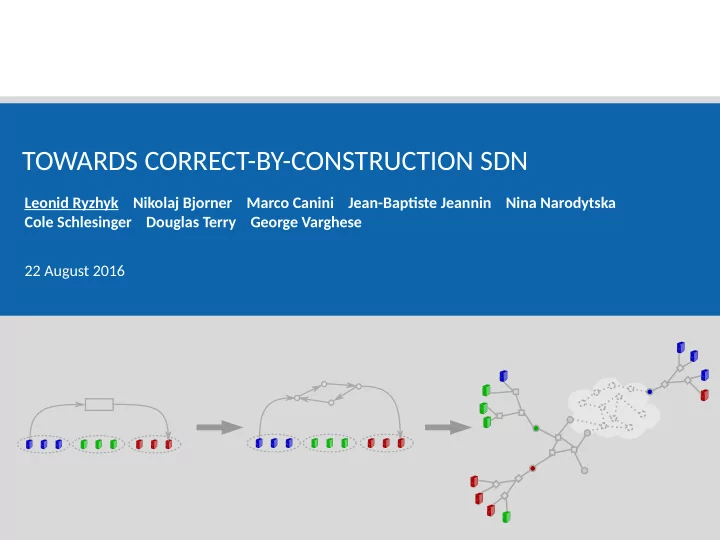

TOWARDS CORRECT-BY-CONSTRUCTION SDN Leonid Ryzhyk Nikolaj Bjorner Marco Canini Jean-Baptjste Jeannin Nina Narodytska Cole Schlesinger Douglas Terry George Varghese 22 August 2016
INTRODUCTION 2 ● Cocoon is a – high-level SDN programming language – verifjcation tool – SDN programming methodology ● … based on the principle of correctness by construction
COCOON IN A NUTSHELL 3 Traditional SDN Verification Workflow Design Implement Run on the Verify generated controller network configuration SDN verification with Cocoon refine refine refine spec implementation Correct by construction
EXAMPLE: CAMPUS NETWORK [Sung et al. Towards Systematic Design of Enterprise Networks] 4 L2 segment Router VLAN Gateway vlan-1 vlan-1 gw router vlan-2 vlan-2 gw router Switch vlan-3 vlan-3 gw router switch router
INTER-VLAN ROUTING: HOP1 5 ACL vlan-1 vlan-1 gw router vlan-2 vlan-2 gw router vlan-3 vlan-3 gw router switch router
INTER-VLAN ROUTING: HOP2 6 ACL vlan-1 vlan-1 gw router vlan-2 vlan-2 gw router vlan-3 vlan-3 gw router switch router
INTER-VLAN ROUTING: HOP3 7 This is messy: ● Large, ad hoc topology ● L2/L3 routing are mixed up ● Complex distributed security policies Typical bugs: ● ACL distribution ● Routing loops ● Black holes vlan-1 vlan-1 gw router Let’s try to untangle this design … vlan-2 vlan-2 gw router vlan-3 vlan-3 gw router switch router
STEP 1: HIGH-LEVEL SPECIFICATION 8 acl() 193.62.*.* 193.63.*.* 193.64.1.*
STEP 2: DISTRIBUTED ACLs 9 acl() 193.62.*.* 193.63.*.* 193.64.1.*
STEP 2: DISTRIBUTED ACLs 10 Gateways aclIn() aclOut() 193.62.*.* 193.63.*.* 193.64.1.* Assumption: acl() ≡ aclOut() Λ aclIn()
STEP 3: L3 ROUTING 11 193.62.*.* 193.63.*.* 193.64.1.*
STEP 3: L3 ROUTING 12 Routers L3NextHop() 193.62.*.* 193.63.*.* 193.64.1.* Assumption: L3NextHop(pkt)* = Gateway(pkt)
STEP 4: L2 SWITCHING 13 193.62.*.* 193.63.*.* 193.64.1.*
STEP 4: L2 SWITCHING 14 193.62.*.* 193.63.*.* 193.64.1.*
STEP 4: L2 SWITCHING 15 L2 switches Assumption: L2NextHop(pkt)* = L3NextHop(pkt)
STEP 4: L2 SWITCHING 16 L2NextHop(pkt.vlan=0) L2NextHop(pkt.vlan=green) L2NextHop(pkt.vlan=red) L2NextHop(pkt.vlan=blue)
SEPARATION OF CONCERNS 17 High-level spec Distributed access control L3 routing L2 switching
WOULDN’T IT BE GREAT TO BUILD SDNs THIS WAY? 18 acl() aclOut() aclIn() 193.62.*.* 193.63.*.* 193.64.1.* 193.62.*.* 193.63.*.* 193.64.1.* With Cocoon, you can! ● Language support for refinement-based programming l3NextHop() ● Automatic compositional verification ● P4 and OpenFlow (via NetKAT) backends 193.62.*.* 193.63.*.* 193.64.1.*
PARAMETERIZED SPECIFICATIONS 19 ● Parameterized specifjcations – Spec may contain undefjned functions , e.g., acl(), l2NextHop(), l3NextHop() – Verifjcation relies on assumptions – These functions are defjned when the network design is instantiated – They can also change at runtime, e.g., in response to link failures – Assumptions are validated when concrete defjnitions are provided (statically or at runtime)
CASE STUDIES 20 Campus network ● [Sung et al. T owards Systematic Design of Enterprise Networks] F10 ● [Liu et al. F10: A Fault-T olerant Engineered Network] B4-style WAN ● [Jain et al. B4: Experience with a Globally-Deployed Software Defjned WAN] iSDX (Software-defjned Internet Exchange) ● [Gupta et al. An Industrial-Scale Software Defjned Internet Exchange Point] NSX-style network virtualization framework ● [Koponen et al. Network Virtualization in Multi-tenant Datacenters] Stag (source-based routing + security labels for fat-tree ● topology)
PERFORMANCE 21 ● All case studies verifjed in ~10 sec, – Compositional verifjcation (1 refjnement at a time) – Parameterized verifjcation amplifjes the power of symbolic reasoning ● No direct comparison (yet) with existing tools like NetKAT, HSA, but expect them to slow down for larger topologies
COCOON VS TRADITIONAL NETWORK VERIFICATION 22 HSA/ NetKAT/ ... Correctness spec
CONCLUSIONS 24 ● Correct-by-construction SDN via iterative refjnement: – Enforces modular design – Enables strong static correctness guarantees – Scales to complex realistic networks
EXAMPLE ASSUMPTION 25 assume (hid_t sid, vid_t vid, MAC dst) (l2distance(sid, vid, dst) > 1) => l2distance(link(sid, l2NextHop(sid, vid, dst)), dst) == (l2distance(sid, vid, dst) - 1)
Recommend
More recommend